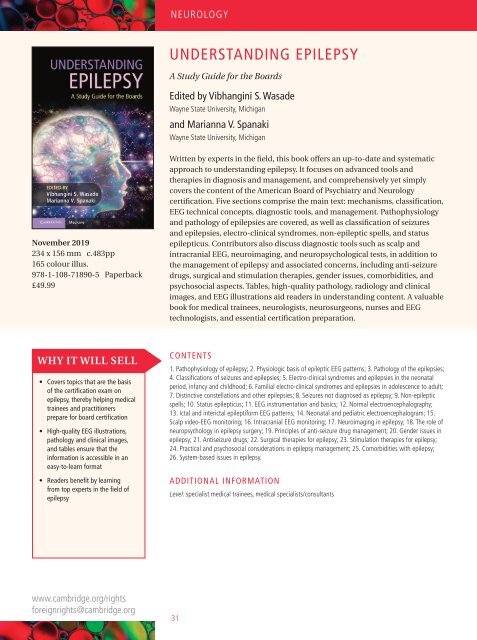Autumn Rights Medical Guide 2019
You also want an ePaper? Increase the reach of your titles
YUMPU automatically turns print PDFs into web optimized ePapers that Google loves.
NEUROLOGY<br />
UNDERSTANDING EPILEPSY<br />
A Study <strong>Guide</strong> for the Boards<br />
Edited by Vibhangini S. Wasade<br />
Wayne State University, Michigan<br />
and Marianna V. Spanaki<br />
Wayne State University, Michigan<br />
November <strong>2019</strong><br />
234 x 156 mm c.483pp<br />
165 colour illus.<br />
978-1-108-71890-5 Paperback<br />
£49.99<br />
Written by experts in the field, this book offers an up-to-date and systematic<br />
approach to understanding epilepsy. It focuses on advanced tools and<br />
therapies in diagnosis and management, and comprehensively yet simply<br />
covers the content of the American Board of Psychiatry and Neurology<br />
certification. Five sections comprise the main text: mechanisms, classification,<br />
EEG technical concepts, diagnostic tools, and management. Pathophysiology<br />
and pathology of epilepsies are covered, as well as classification of seizures<br />
and epilepsies, electro-clinical syndromes, non-epileptic spells, and status<br />
epilepticus. Contributors also discuss diagnostic tools such as scalp and<br />
intracranial EEG, neuroimaging, and neuropsychological tests, in addition to<br />
the management of epilepsy and associated concerns, including anti-seizure<br />
drugs, surgical and stimulation therapies, gender issues, comorbidities, and<br />
psychosocial aspects. Tables, high-quality pathology, radiology and clinical<br />
images, and EEG illustrations aid readers in understanding content. A valuable<br />
book for medical trainees, neurologists, neurosurgeons, nurses and EEG<br />
technologists, and essential certification preparation.<br />
WHY IT WILL SELL<br />
• Covers topics that are the basis<br />
of the certification exam on<br />
epilepsy, thereby helping medical<br />
trainees and practitioners<br />
prepare for board certification<br />
• High-quality EEG illustrations,<br />
pathology and clinical images,<br />
and tables ensure that the<br />
information is accessible in an<br />
easy-to-learn format<br />
• Readers benefit by learning<br />
from top experts in the field of<br />
epilepsy<br />
CONTENTS<br />
1. Pathophysiology of epilepsy; 2. Physiologic basis of epileptic EEG patterns; 3. Pathology of the epilepsies;<br />
4. Classifications of seizures and epilepsies; 5. Electro-clinical syndromes and epilepsies in the neonatal<br />
period, infancy and childhood; 6. Familial electro-clinical syndromes and epilepsies in adolescence to adult;<br />
7. Distinctive constellations and other epilepsies; 8. Seizures not diagnosed as epilepsy; 9. Non-epileptic<br />
spells; 10. Status epilepticus; 11. EEG instrumentation and basics; 12. Normal electroencephalography;<br />
13. Ictal and interictal epileptiform EEG patterns; 14. Neonatal and pediatric electroencephalogram; 15.<br />
Scalp video-EEG monitoring; 16. Intracranial EEG monitoring; 17. Neuroimaging in epilepsy; 18. The role of<br />
neuropsychology in epilepsy surgery; 19. Principles of anti-seizure drug management; 20. Gender issues in<br />
epilepsy; 21. Antiseizure drugs; 22. Surgical therapies for epilepsy; 23. Stimulation therapies for epilepsy;<br />
24. Practical and psychosocial considerations in epilepsy management; 25. Comorbidities with epilepsy;<br />
26. System-based issues in epilepsy.<br />
ADDITIONAL INFORMATION<br />
Level: specialist medical trainees, medical specialists/consultants<br />
www.cambridge.org/rights<br />
foreignrights@cambridge.org<br />
31<br />
41583.indd 31 05/09/<strong>2019</strong> 10:12



